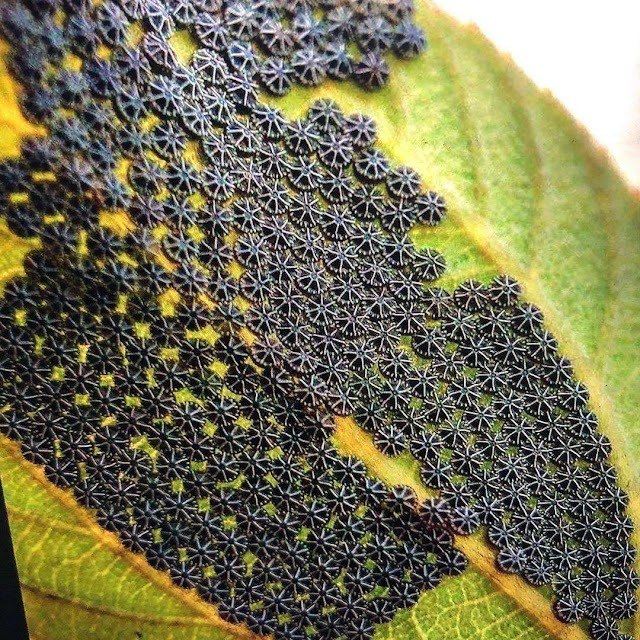ADVERTISEMENT
- Don’t touch aphids directly—they can easily transfer to your hands and spread from plant to plant.
- Use insecticidal soap or introduce natural predators, like ladybugs or lacewings, to control aphid populations.
- If the infestation is severe, prune off the affected leaves or use a strong stream of water to wash them away.
3. Spider Mites (Tetranychidae) 🕷️
Why You Should Avoid Them: Spider mites are tiny, often invisible to the naked eye, but they can cause serious damage to your plants. They puncture plant cells and suck out the contents, causing leaves to become speckled, discolored, or scorched. In heavy infestations, spider mites can kill the plant.
What to Do:
- Avoid handling plants that are infested with spider mites, as they can spread to other plants and your clothing.
- Use a miticide or insecticidal soap to control the infestation.
- Increase humidity around the plants since spider mites thrive in dry conditions. Regularly misting plants or using a humidifier can help deter them.
4. Slugs and Snails (Gastropoda) 🐌
Why You Should Avoid Them: Slugs and snails are slow-moving but incredibly destructive. They feed on plant leaves, leaving large holes and causing plants to weaken. Some species carry parasites that can be harmful to humans and pets.
What to Do:
- Avoid touching slugs and snails directly, especially if you’re handling plants that could be contaminated with parasites.
- Set up barriers using diatomaceous earth, copper tape, or crushed eggshells to deter slugs and snails.
- Use beer traps or commercial slug baits to control them.
- Collect them by hand at night (when they are most active) and dispose of them away from your garden.
5. Whiteflies (Trialeurodes vaporariorum) 🦋
Why You Should Avoid Them: Whiteflies are small, white insects that cluster on the undersides of leaves, feeding on plant sap. They can quickly multiply and damage plants, leaving behind a sticky residue called honeydew that attracts mold. They can also spread diseases like the tomato yellow leaf curl virus.
What to Do:
- If you see whiteflies, don’t touch them with your bare hands, as this can spread them around.
- Use yellow sticky traps to catch adult whiteflies and insecticidal soap or neem oil to target them.
- For Complete Cooking STEPS Please Head On Over To Next Page Or Open button (>) and don’t forget to SHARE with your Facebook friends
- Natural predators, such as parasitic wasps or lacewings, can help control whitefly populations.
6. Mealybugs (Pseudococcidae) 🐞
Why You Should Avoid Them: Mealybugs are soft-bodied insects that secrete a waxy coating, making them look like little cotton balls. They can infest many types of plants and feed on plant sap, causing leaves to yellow and stunt growth. In large numbers, mealybugs can even cause plant death.
What to Do:
- Avoid handling infested plants, as the mealybugs can easily transfer to your skin or clothing.
- Use rubbing alcohol (isopropyl alcohol) on a cotton ball to dab directly on the mealybugs. This will kill them instantly.
- Introduce natural predators, like ladybugs or lacewing larvae, to help control mealybug populations.
7. Stinging Nettles (Urtica dioica) 🌿
Why You Should Avoid Them: While stinging nettles have medicinal uses, they can cause severe skin irritation upon contact. The tiny, needle-like hairs on the plant release chemicals that lead to a painful rash, itching, and redness.
What to Do:
- Avoid touching the leaves or stems of stinging nettles. If you do come into contact with them, use gloves for protection.
- Wear long sleeves and pants when working in areas where nettles are growing.
- To soothe skin irritation, wash the affected area with soap and water and apply calamine lotion or a cool compress.
8. Caterpillars of Certain Moths (Lepidoptera) 🦋
Why You Should Avoid Them: Certain caterpillars, like the tomato hornworm, can devour plants quickly, leaving large, unsightly holes in leaves. Some species of caterpillars are also toxic if ingested, so it’s best to avoid handling them.
What to Do:
- Don’t touch caterpillars directly, as some can have toxic spines or glands.
- You can hand-pick caterpillars off plants or use natural predators like birds or parasitic wasps.
- For severe infestations, organic insecticides can help control them.
Conclusion:
Gardening is full of rewards, but it’s also important to be aware of the dangers that come with certain pests. The key is knowing which ones to avoid and how to handle them safely. By staying informed and taking the proper precautions, you can keep your plants healthy and your garden thriving—while avoiding any unwanted bites, stings, or rashes!
So, if you spot any of these pests in your garden, take care to protect yourself and your plants. And always remember, when in doubt, don’t touch. Happy gardening! 🌸🌿
